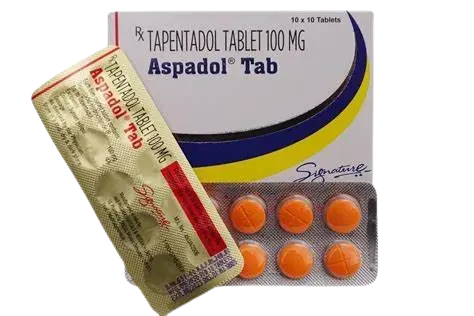Tapentadol vs Tramadol: Which Painkiller Is Better in Australia?

Introduction
Pain is a significant issue in the Australian population, affecting one out of five people, impacting their work performance, and interfering with their day-to-day activities. Tapentadol and Tramadol are two centrally acting analgesics with selectivity for mu-opioid receptors that exhibit analgesic or pain-relief in a wide range of acute and chronic cases. A comparison of the pharmacological profiles of the medication have proven that despite the similar mechanism of action, Tapentadol MOR ( mu-opioid receptor activity ) is several fold greater than that of Tramadol. In addition Tapentadol has greater gastrointestinal tolerability in comparison to traditional opioids.
But in order to understand which of the two is best suited for your pain conditions, it is imperative to delve deeper into their pharmacokinetics and pain mechanisms in detail.
Understanding the Medications
Traditionally, opioid analgesics are regarded as the mainstream treatment for algesia that block calcium channels and inhibit the release of neurotransmitters to contribute to nociception or pain-relieving effects. But opioids are also controversial because of their potential for addiction and side effects.
Image Credit - https://www.researchgate.net/figure/Opioid-mechanism-of-action-Opioids-bind-to-their-m-k-and-d-receptors-at-presynaptic_fig1_369872688
In contrast, Mu-opioid analgesics are a relatively safer option that retains their opioid analgesic properties with significantly fewer or no side effects. Both Tapentadol and Tramadol are synthetic opioids that bind to mu-opioid receptors and inhibit the reuptake of norepinephrine to reduce pain signals, thus earning the name mu-opioid analgesics.
Image Credit - Tramadol and Tapentadol: Clinical and Pharmacologic Review
Tapentadol is an atypical opioid with a unique mechanism of action that was first launched at the end of 2011. It is regarded as the representative of a new pharmacological class of centrally acting analgesics, chiefly mu-opioid receptor agonists, that has been described by human and animal studies as safe and effective. An important property of Tapentadol is its negligible serotonin reuptake inhibition triggered adverse effects and its non-dependence on metabolic activation that make it gastro-friendly.
Image Credit - https://www.researchgate.net/figure/Tapentadol-mechanism-of-action-at-spinal-level_fig2_333129655
Tramadol is a centrally-acting analgesic structurally related to morphine and codeine that consists of two enantiomers ;(+)-Tramadol and the metabolite (+)-O-desmethyl-tramadol (M1), resulting in dual analgesic activity. It inhibits serotonin reuptake and norepinephrine reuptake, resulting in enhanced inhibitory effects on pain transmission in the spinal cord. The complementary and synergistic actions of the two enantiomers result in improved analgesic efficacy and tolerability.
Image Credit - https://www.sciencedirect.com/science/article/pii/S0753332218373694
Despite its dual mechanism of action, the effectiveness of Tramadol varies significantly because of individual differences in CYP2D6 metabolism, resulting in unpredictable analgesic effects.
Image Credit - Mechanism and sites of action of the opioids tramadol and Tapentadol. α 2 R = alpha-2 receptors, GLU = glutamate, SP = substance P.
Effectiveness for Pain Relief
For back pain :
Research has shown that Tapentadol at 600 mg per day provides thrice the efficacy of Tramadol 400 mg and is especially effective for back pain.In a retrospective observational study conducted on 732 patients with lower back pain, 91 patients with Tapentadol use reported better evolution of pain than 414 individuals using Tramadol. Out of the enrolled patients, those in the Tapentadol group were younger and had a significantly increased pain intensity than the Tramadol group. Hypertension and fractures of the back were more common in this group.In the very first month, patients using Tapentadol recorded improved VAS ( Visual Analogue Scale ) for pain and an improvement in overall well-being because of the reduced pain.
Image Credit - https://pmc.ncbi.nlm.nih.gov/articles/PMC5690718/
The pain relief was especially significant from days 8 to 14, and clinicians observed that the adverse reactions were minimal. Tapentadol showed a clear advantage over Tramadol in back pain analgesic relief and was well tolerated.
Cancer pain :
Algesia or pain is common in cancer patients that can stem from the cancer, its treatment, or other issues and manifest in the form of acute, chronic, or breakthrough pain.In Australia, cancer pain is a significant issue, with studies indicating that around 75% of people with cancer experience pain, yet it remains undertreated. In such cases, an effective analgesic intervention is much needed in improving the patients quality of life. Studies evaluating the efficacy of Tapentadol and Tramadol in head and neck cancer patients have shown that single-agent Tapentadol provides statistically superior pain control than Tramadol or its combination therapies. Other studies conducted in patients with breast cancer or cancer of the prostate or respiratory tract have shown a higher response rate to Tapentadol, especially in those with neuropathic pain.
Neuropathic pain :
Neuropathic pain that is caused by nerve injury or damage impacts 7-10 % of Australians and is associated with a poor quality of life.Clinical trials have shown that Tapentadol comes in handy as an effective and safe option for neuropathic pain conditions, especially in elderly patients. A comparison of data on the pharmacological and toxicological profiles of Tapentadol and Tramadol have proven that Tapentadol is an effective option for neuropathic pain with lower abuse liability and less side effects.
For postoperative pain :
In a double-randomized study of the safety and efficacy of Tapentadol and Tramadol for postoperative pain conditions, the results showed the pain reduction to be higher in the Tapentadol group. While both the medications were well tolerated, Tapentadol showed greater efficacy and tapentadol users were able to sleep better with minimal sleep disturbances.
Side Effects and Safety Profile
Keeping in mind the fact that Tapentadol and Tramadol are analgesics with a mixed mechanism of action, some authors have proposed the concept of “mu load”, a measure of how much of a drug’s effect and side-effects comes from mu-opioid activity even when the medication works in other ways.The mu load of Tapentadol is less than 40% compared to pure mu agonists, resulting in a favourable adverse effect profile as compared to traditional opioids. Side effects of Tapentadol are chiefly in the form of nausea, vomiting, and a dry mouth, which are observed as well with Tramadol at times. What sets Tramadol apart from Tapentadol in this regard is that it relies on CYP2D6 enzymes for activation, resulting in additional serotonergic adverse effects like headache, hypoglycemia, and the risk of serotonin syndrome.
Even though Tramadol has a lower mu load than Tapentadol, it needs to be metabolized into an active form, resulting in unpredictable metabolism with variable effects. While side effects with Tapentadol are more in the form of opioid adverse reactions like respiratory depression, Tramadol use results in serotonergic adverse effects like hypoglycemia and dizziness.Overall, the efficacy and safety of Tapentadol are reassuring in elderly individuals, but there is insufficient evidence to support its use in vulnerable elderly patients, and it should be avoided in people with severe renal or hepatic impairment.
Dependency and Abuse Potential
Both Tapentadol and Tramadol are chemically related opioids that, though safer than classical opioids, are associated with neurotoxicity and behavioral function.
Animal studies have shown that Tapentadol and Tramadol have the potential to alter the hippocampal molecules (which play an important role in memory and learning and contribute to opioid dependence ) and result in behavioral implications when overused because of which they should be used cautiously and tapered before discontinuing.Particularly high and toxic doses of the two medications can further cause lung, kidney, and liver damage in addition to increased risk of seizures and serotonin syndrome with Tramadol use, because of which either medication should be used with caution.
In-vitro study conducted with 10, 25 and 50 mg/kg of Tapentadol and Tramadol , an intermittent dose and a daily dose have observed toxicological effects like protein oxidation in the liver and kidney coupled with increased serum lipid levels, decreased urea concentration increased alanine aminotransferase and decreased butyrylcholinesterase activities.
Histopathological findings have indicated proteinuria and decreased glomerular filtration with overuse of Tapentadol and Tramadol, which are signs of renal impairment.Long-term abuse can also result in metabolic stress, inflammation, and injury, resulting in swollen cells, fat deposits, cell build-up, and immune damage.For the safety of the patient, Tapentadol and Tramadol use should be avoided in individuals with hepatic and renal complications and people intolerant to their ingredients.
In case the adverse reactions persist or increase in intensity, discontinue the medication and get urgent medical help.
Availability and Prescription Trends in Australia
Tapentadol and Tramadol have been available in Australia since 2011 and have a controlled status, i.e., they are available only through prescription. Recent years have seen an increase in Tapentadol use, with a five-year patient dispensing analysis of the medication seeing an increase in hospital prescriptions.
According to the survey, Tapentadol IR prescriptions increased by 223.2 % between 2018-2019 and 2020-2121. Sustained-Release Tapentadol prescriptions increased by 17.9% from 2016-17 to 2020-2021. By 2020-2021, Tapentadol overtook Oxycodone to become the most prescribed opioid in Sydney's local health district. At the hospital's surgical units, 97.9% of patients were prescribed Tapentadol for acute postoperative pain. 54% were prescribed both IR and SR forms, while 71.1% were prescribed Tapentadol for neuropathic pain in the spinal units,
In contrast Tramadol prescriptions decreased over the five-year period with Immediate-Release Tramadol prescriptions dropping by 74.6% and Sustained-Release formulations dropping by 70.1%.
Overall, Tramadol prescriptions have dropped by 21% between 2015 and 2022, driven by a 33 % reduction in PBS dispensing claims.
Cost and Accessibility :
Despite its popularity, Tapentadol in Australia is not listed under PBS. SR formulations are partially subsidized by PBS, IR formulations are not subsidized, leading to a higher cost and resulting in reduced accessibility for some individuals.Unlike Tapentadol, Tramadol is listed under the PBS in Australia, which subsidizes its cost and makes it more affordable to patients.
Even with the lack of PBS listing, Tapentadol popularity is ever on the rise and recent years have observed an increase in its sales. By 2020-2021, Tapentadol has overtaken Oxycodone to become the most prescribed opioid analgesic in Australia, with a growth rate of 51%.
Doctor and Patient Perspectives
A review of a clinical trial published in the Association of Anaesthetists has demonstrated the efficacy of Tapentadol over Tramadol in providing analgesic relief.
A summary of the paper reviewing Phase 1 and 2 Trials and randomized controlled trials has demonstrated that Tramadol is a racemic mixture of (+) and (-) enantiomers and actively metabolized, unlike Tapentadol, which is a single enantiomer and has no active metabolites. The absence of active metabolites results in decreased risk of drug interactions along with lowering the risk of serotonin syndrome significantly. It even enables it a favorable gastronomic profile.The paper states that the parent compound of Tramadol has a predominantly monoaminergic effect, but the opioid effect resides on the (+)- enantiomer of its metabolite, which causes patient variability in its response. These factors further make the analgesic effect of Tramadol less effective and predictable than Tapentadol.
Tapentadol, while being less prone to adverse drug interactions, has significantly less patient response variability and is preferred by physicians in moderate to severe pain. The study concludes that the notion that Tapentadol is an expensive cousin of Tramadol is misleading. Even though they have similar effects and help manage pain, both medications are very different.Patient perspectives favour Tapentadol over Tramadol as well.A review of several clinical trials has demonstrated a decrease in pain intensity and improved VAS and SF-36 ( markers of patient satisfaction ) with Tapentadol along with fewer clinic revisits . According to the NIH patients prefer Tapentadol and Tramadol for pain relief but prefer Tapentadol because of its safety profile and fewer gastrointestinal side-effects.
So, Which One Is Better?
The sum-total of animal studies and clinical trials have proven that Tapentadol and Tramadol are both mu-opioid analgesics working on acute and pain conditions. That said, Tapentadol is two to five times more potent than Tramadol and approved by physicians and patients. Tapentadol comes in useful in acute and chronic pain conditions not responding satisfactorily or intolerant to traditional opioids and is especially useful for chronic back pain, neuropathic pain, cancer pain, and post-surgical pain, providing the patient symptomatic relief and helping improve the quality of life significantly.
Tapentadol and Tramadol have a relatively safe profile when used under the physician's guidance.even then, side effects are relatively scarce in Tapentadol and greater in Tramadol because of their molecular differences.Because of its safety and effectiveness, Tapentadol use is on the rise in Australia despite not being listed under the PBS. Tramadol is suited for pain conditions that do not require strong opioid components. It is a welcome option for moderate pain and has the advantage of affordability because it is listed under the PBS.
Conclusion.
Studies have shown that chronic pain impacts a large part of the adult Australian population, including the working-age population, and is strongly associated with markers of social disadvantage.Both Tapentadol and Tramadol have their own characteristic way of working on the pain receptors and providing symptomatic relief to the patient.
They have an abuse potential as well and should be used in prescribed dosage for the safety of the patient.Consult your physician and discuss your pain conditions and systemic history before starting either medication to obtain pain relief without any adverse reactions or side effects.
Chronic pain in Australia: a prevalence study - PubMed.
https://pubmed.ncbi.nlm.nih.gov/17087119/
https://www.ncbi.nlm.nih.gov/books/NBK560692/
https://pubmed.ncbi.nlm.nih.gov/28935293/
https://pubmed.ncbi.nlm.nih.gov/22786465/
https://pubmed.ncbi.nlm.nih.gov/22698264/
https://pmc.ncbi.nlm.nih.gov/articles/PMC8520146/
https://pmc.ncbi.nlm.nih.gov/articles/PMC5690718/
Tapentadol ‐ the evidence so far - Ramaswamy - 2015 - Anaesthesia - Wiley Online Library.
https://pubmed.ncbi.nlm.nih.gov/29369473/
https://www.ijbcp.com/index.php/ijbcp/article/view/2093
https://pubmed.ncbi.nlm.nih.gov/38931463/
https://pubmed.ncbi.nlm.nih.gov/28689766/
https://pmc.ncbi.nlm.nih.gov/articles/PMC9544395/?utm_source=chatgpt.com
Please log in to add a comment.
Dr. James Lawson, a distinguished expert in pain management and pharmaceutical sciences. With over 20 years of medical experience, Dr. Lawson remains deeply committed to advancing safe and effective pain relief solutions. Though no longer in active clinical practice, his passion for healthcare and dedication to patient education continue to thrive. Through his extensive research and medical writing, Dr. Lawson supports our pharmacy’s mission by providing trusted insights on pain management, helping our valued customers make informed health decisions.

.svg)
Delivered in secure, plain packaging on fully tracked delivery from just £20.

Our team of doctors and pharmacists, and our support staff, are all AUS-based.
.svg)
Have a question? Telephone support is always free; Monday - Friday, 9am - 5pm.
